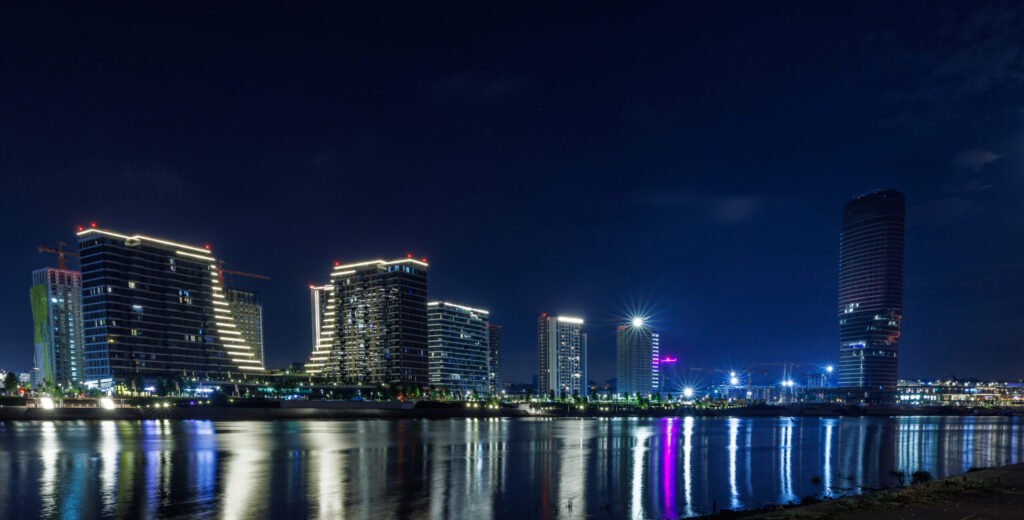However, the reality behind these grand announcements tells a different story. Infrastructure projects are those which spark public discontent, fueled by concerns over mismanagement and corruption. The practices surrounding public procurement and contractor selection play a critical role in assessing the government’s genuine commitment to aligning with European Union (EU) standards. Public procurements are examined across Chapter 5 of the EU accession process, one of the Fundamental Chapters, given the importance of public procurements in the EU, examining these practices offers valuable insight into Serbia’s readiness for European integration.
Theory and practices of Serbia’s public procurement policy
Major infrastructure projects in Serbia are often governed by extraordinary legislation that bypasses standard procurement protocols. These exemptions limit transparency, hiding critical aspects such as feasibility, profitability, financing, and contractor selection from the public scrutiny. An example is the October 2023 parliamentary decision to exempt the public body managing EXPO Belgrade 2027 from adhering to Serbia’s reformed public procurement laws.[2] This decision directly opposed recommendations from the European Commission, which emphasized compliance with the reformed framework which had previously been positively evaluated, matching EU standards.[3]
The systematic circumvention of laws and the lack of practical implementation raise concerns about the proper use of public funds and taxpayers’ money. European funding, with its strict methodologies and regular audits, is standing alongside investments that are arbitrarily subject to minimal controls. All too often, these turn out to be money-laundering machines.
Above all, numerous projects never see the light of day even if numerous public spendings were already consumed. Projects are regularly mentioned, only to disappear and then suddenly reappear in the next investment plan. The most emblematic case is the Belgrade metro, which is going through a phase of embellishment but is a project that is several decades old.[4] Recently, the Old German Bridge, one of the two bridges linking Belgrade city centre and Novi Beograd, is being dismantled. This bridge is undeniably old and no longer corresponds to contemporary standards. However numerous residents do not trust the contractor company entitled to the work to build up a safer and valuable bridge. Indeed, these investments and infrastructures, having very low regulation, are putting users’ lives at risk.
In Novi Sad, the main station canopy which had been renovated for few years and officially opened in the summer, collapsed in the morning of November 1st 2024. A catastrophe which caused the death of 15 people, and tens were injured. Yet the station was inaugurated in July, with politicians showering praise on the quality of the refurbishment done by two Chinese construction companies.[5]
The investments and new infrastructure are showcased as reflections of economic wellbeing and the catch-up of the continent’s standards. In practice, the ruling Serbian Progressive Party (SNS) apparatus is reluctant to conform to the EU legal framework. The SNS, which counts at least 700,000 members, the largest party by membership in Europe (excluding Turkey), especially among 6,5 million citizens, is infamously known for its documented embezzlement, clientelist and interference practices.[6] Searching to conserve their grip on State resources, decision-makers linked to the SNS prefer to contract with non-Western stakeholders, especially from China, Russia and the Gulf states, which are providing non-disclosure agreements. The Belgrade Waterfront project, which completely transformed the riverfront of the capital city, was thus led without any scrutiny by an Emirati investor.[7]
Serbia’s geopolitical orientation towards the Belt and Road Initiative
In 2009, Belgrade and Beijing signed on infrastructure cooperation, lifting some restrictive tendering procedures for Chinese companies to bid for public contracts. However, the Chinese investment emergence started in 2012 when the conservative SNS came to power. Despite figures emerging revealing their relatively costly non-competitiveness, the Serbian authorities seized the opportunity of opaque investment inflows. Chinese investments in Serbia are to this day a win-win agreement for the development of corruption schemes.[8]
At the end of 2021, the Balkan Investigative Reporting Network (BIRN) carried out a survey and published a compilation of information on China’s presence in the Balkans. Out of the 136 listed projects in the Western Balkans countries, half of them and 60% of the global value (18,8 out the committed 36 billions of euros) were directed to Serbia. According to the survey data on project transparency, two projects are open (the construction of the two Confucius Institutes), 15 projects are considered to have partial transparency, and the remaining 44 projects were financed in an opaque manner.[9]
Are the European stakeholders driving wealthy economic growth?
Research conducted in the last two decades in the West of Serbia revealed one of the biggest lithium deposits in Europe. Rio Tinto – a mining corporation, recognized the opportunity and started project “Jadar”, aiming to extract and process lithium. Although the project was fiercely opposed by environmentalist groups in Serbia, the EU decided to support the mining project. On 11 July 2024, the moratorium on lithium mining in the Jadar Valley was lifted by the Serbian Constitutional Court. On the starting block to secure a regional deposit of strategic resources, the European Commission agreed that Olaf Scholz and Maroš Šefčovič immediately scheduled a visit to Belgrade. On 17 July, he signed an agreement with the Serbian government on behalf of the European Union to secure European companies’ priority access to the lithium to be mined.
The EU came up against part of the Serbian public opinion, which is alarmed by the environmental risks and previously pressured authorities to hold on the deposit extraction. Whereas China’s investments are directed towards extraction industries with limited economic spin-offs locally, the EU is about to follow the same strategy. The Memorandum of Understanding which ratified access to lithium for players in the common market announces that this agreement is becoming an important guarantee of Serbian European integration.[10]
The lack of transparency in investments facilitates and generates speculative schemes that are proving damaging to the Serbian economy. Major project policies are even proving to be the source of the main protest movements. The realities of the extractive economy, coupled with arbitrary power and foreign stakeholders’ growing presence, led some to describe Serbia’s geoeconomic situation as colonial.[11] This notion has thus entered the Serbian public debate, with the slogan ‘Serbia will not be a mining colony of Europe’ displayed on the placards of demonstrators.
Through pre-accession funding frameworks, EU public stakeholders are providing tens of millions to the connectivity and the structural development of the Western Balkans. Seizing them requires public authorities to follow EU-compliant methodologies. The European institutions must also ensure that the growing private investments are contributing as well to Serbia’s EU integration and its rule of law system. Existing monitoring mechanisms of the EU proved ineffective in combating misuse of public and EU funds, while EU standards and domestic laws in Serbia are too often bypassed. Therefore, there is a necessity for the EU to adjust and more rigorously address these issues in Serbia.
Sources
FDI inflows / outflows in GDP 2021 – World Bank
National Assembly of Serbia Adopts Special Law for Construction of Facilities for EXPO 2027, Ekapija, 27.10.23
Monitoring report 2021 Serbia – SIGMA OECD – 18.11.2021
Le métro de Belgrade : un projet fantôme ? Balkoninfluences 17.12.2019
The Chinese worked on the reconstruction under the ‘veil’ of secrecy: Who is responsible for the deaths at the train station in Novi Sad? The Geopost. 02.11.2024
Belgrade Waterfront, un cauchemar sur l’eau ?, Eurocreative , S. Clugnac-Pavlovic, 12.10.2024
La Chine, une “amitié de fer” avec la Hongrie et la Serbie, L’Echo, 06.05.2024
BIRN Presents Online Plateform on China’s activities in Western Balkans, BIRN, december 2021
EU and Serbia sign strategic partnership on sustainable raw materials, European Commission, 19.07.2024
Rio Tinto : comment Vučić fait de la Serbie « une colonie minière de l’Europe », Le Courrier des Balkans, Aleksandar Matkovic, 26.08.2024
_______________________
[1] FDI inflows / outflows in GDP 2021 – World Bank
[2] National Assembly of Serbia Adopts Special Law for Construction of Facilities for EXPO 2027, Ekapija, 27.10.23
[3] Monitoring report 2021 Serbia – SIGMA OECD – 18.11.2021
[4] Le métro de Belgrade : un projet fantôme ?.Balkoninfluences.17.12.2019
[5] The Chinese worked on the reconstruction under the ‘veil’ of secrecy: Who is responsible for the deaths at the train station in Novi Sad?.The Geopost. 02.11.2024
[6] The Vucic System, an analysis of the concentration and consolidation of power. Friedrich Naumann Stiftung. Jovan Jovanovic 11.2021
[7] Belgrade Waterfront, un cauchemar sur l’eau ?, Eurocreative. S. Clugnac-Pavlovic. 12.10.2024
[8] La Chine, une “amitié de fer” avec la Hongrie et la Serbie. L’Echo. 06.05.2024
[9] BIRN Presents Online Plateform on China’s activities in Western Balkans, BIRN, december 2021
[10] EU and Serbia sign strategic partnership on sustainable raw materials, European Commission, 19.07.2024
[11] Rio Tinto : comment Vučić fait de la Serbie « une colonie minière de l’Europe », Le Courrier des Balkans, Aleksandar Matkovic, 26.08.2024








